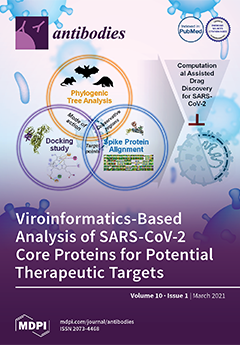Open AccessFeature PaperArticle
An Immunoregulatory Role for Complement Receptors in Murine Models of Breast Cancer
by
Fazrena Nadia Md Akhir, Mohd Hezmee Mohd Noor, Keith Weng Kit Leong, Jamileh A. Nabizadeh, Helga D. Manthey, Stefan E. Sonderegger, Jenny Nga Ting Fung, Crystal E. McGirr, Ian A. Shiels, Paul C. Mills, Trent M. Woodruff and Barbara E. Rolfe
Cited by 14 | Viewed by 5969
Abstract
The complement system has demonstrated roles in regulating tumor growth, although these may differ between tumor types. The current study used two murine breast cancer models (EMT6 and 4T1) to investigate whether pharmacological targeting of receptors for complement proteins C3a (C3aR) and C5a
[...] Read more.
The complement system has demonstrated roles in regulating tumor growth, although these may differ between tumor types. The current study used two murine breast cancer models (EMT6 and 4T1) to investigate whether pharmacological targeting of receptors for complement proteins C3a (C3aR) and C5a (C5aR1) is protective in murine breast cancer models. In contrast to prior studies in other tumor models, treatment with the selective C5aR1 antagonist PMX53 had no effect on tumor growth. However, treatment of mice with a dual C3aR/C5aR1 agonist (YSFKPMPLaR) significantly slowed mammary tumor development and progression. Examination of receptor expression by quantitative polymerase chain reaction (qPCR) analysis showed very low levels of mRNA expression for either
C3aR or
C5aR1 by EMT6 or 4T1 mammary carcinoma cell lines compared with the J774 macrophage line or bone marrow-derived macrophages. Moreover, flow cytometric analysis found no evidence of C3aR or C5aR1 protein expression by either EMT6 or 4T1 cells, leading us to hypothesize that the tumor inhibitory effects of the dual agonist are indirect, possibly via regulation of the anti-tumor immune response. This hypothesis was supported by flow cytometric analysis of tumor infiltrating leukocyte populations, which demonstrated a significant increase in T lymphocytes in mice treated with the C3aR/C5aR1 agonist. These results support an immunoregulatory role for complement receptors in primary murine mammary carcinoma models. They also suggest that complement activation peptides can influence the anti-tumor response in different ways depending on the cancer type, the host immune response to the tumor and levels of endogenous complement activation within the tumor microenvironment.
Full article
►▼
Show Figures






